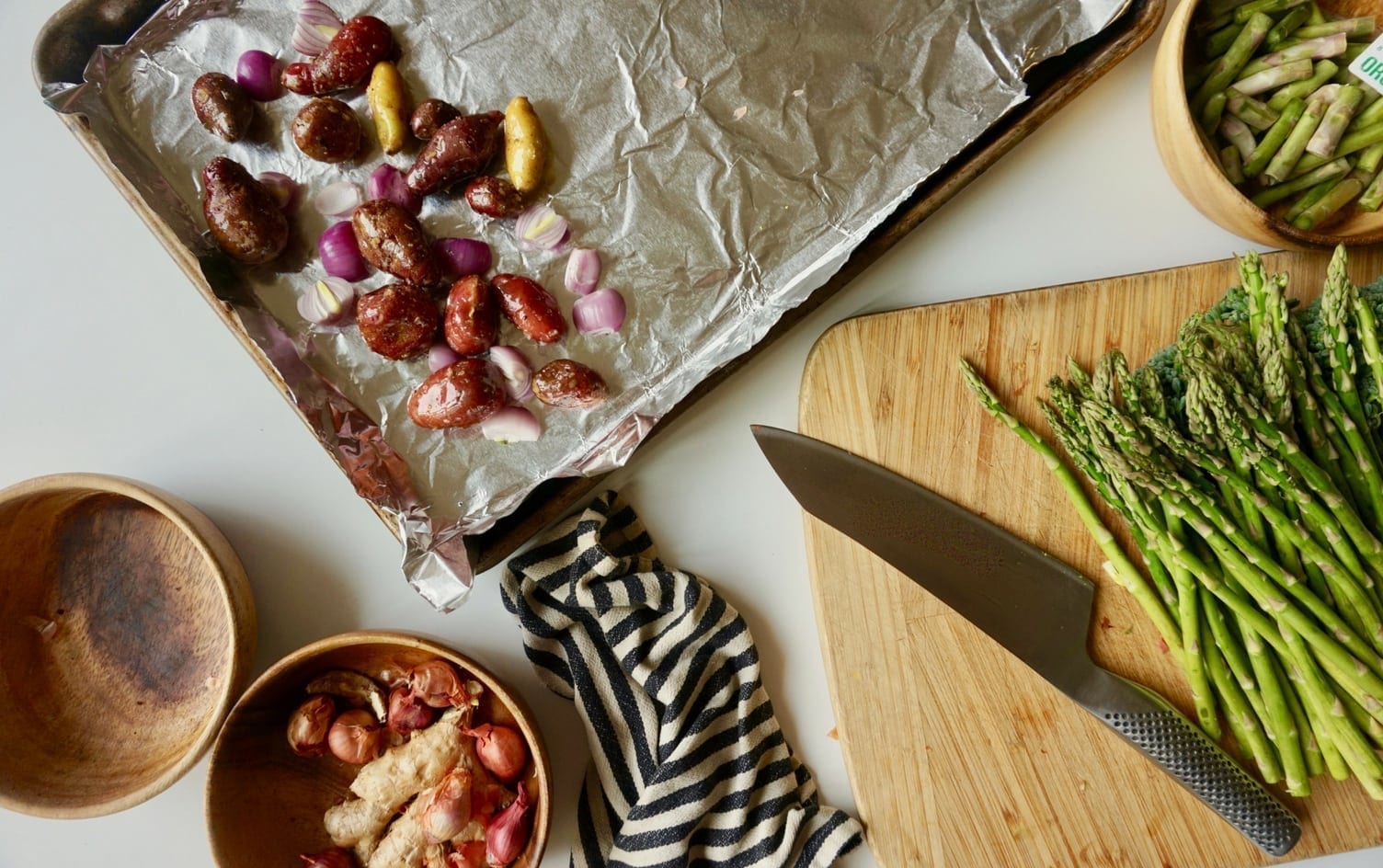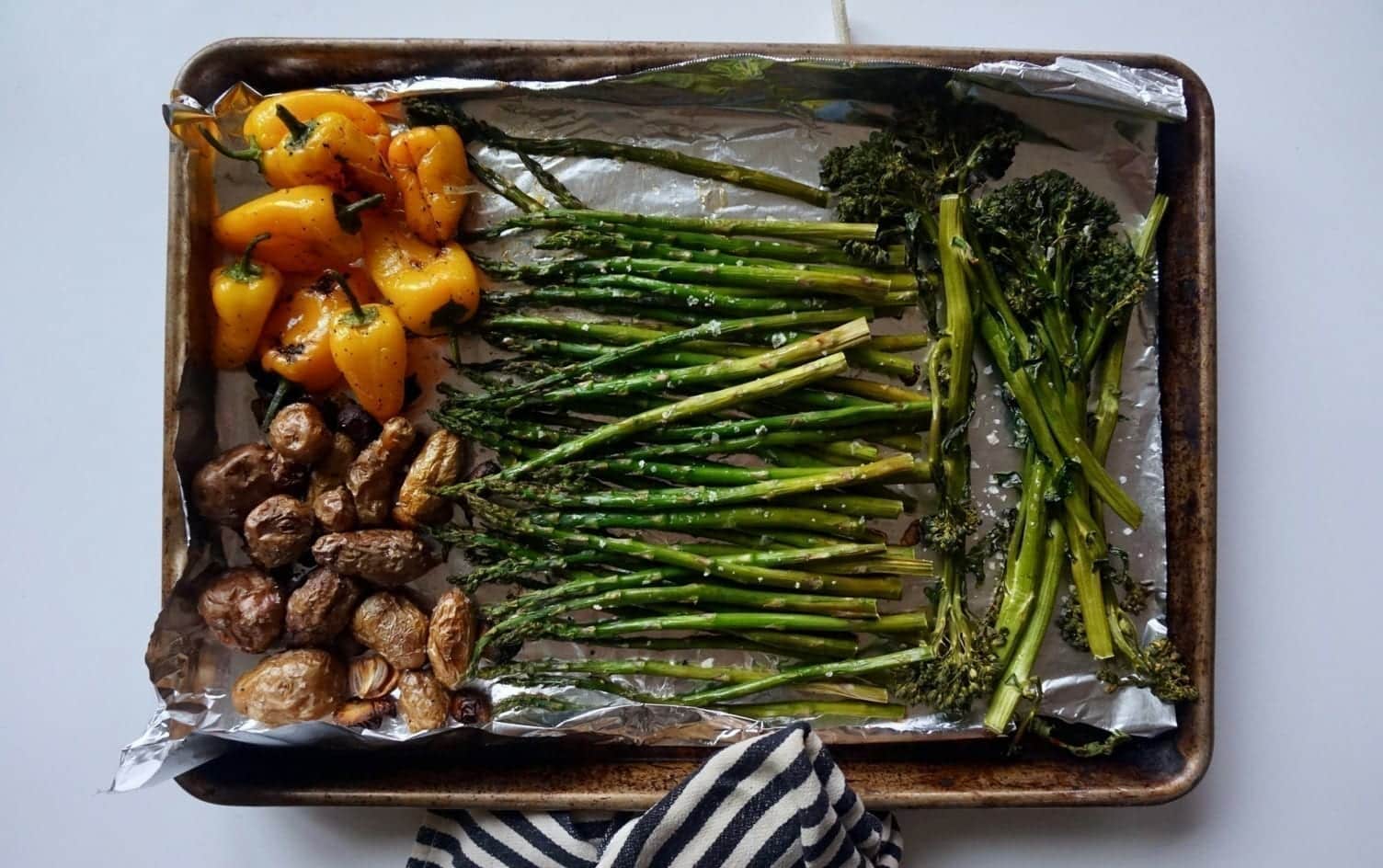Yes, you can absolutely use your oven as part of your meal prep process to pre-roast veggies for salads and sides later in the week, but why stop there? A surefire way to make meal prep a breeze is to craft a few sheet pan meals to make cooking and cleanup a snap.
Basically anything can become a sheet pan meal. Fish, potatoes and veggies. Chicken, chicories and citrus. Spread a pizza crust out on a trusty sheet, slather it in other tasty stuff and you’ve got a pizza. Toss heads of romaine on a sheet pan and pop it in the oven for just a few minutes to create a whole new salad sensation. And, want showstopper for dessert? Make it on a sheet pan, then portion it out for the week (or serve it up to a crowd!)
At their best, sheet pan meals are as flavorful as any meal you spent hours cooking (and used multiple pots and pans); at their worst, sheet pan meals are a random jumble of unpaired flavors.

The 10 tips below will help you organize, prep, cook and serve or store the bounty from this new favorite way to whip up dinner (or a week’s worth of dinners at once):
1. BUY A COMMERCIAL-GRADE HALF-SHEET PAN
This ensures that whatever you’re cooking has plenty of space to cook without getting crowded by other ingredients (and therefore steamed, instead of roasted to crisp perfection). The kind of sheet pan matters; you want one that’s at least 13-by-18-inches, and you want one with a rim.
2. PAIR VEGETABLES AND PROTEINS WITH SIMILAR COOKING TIMES
Making a great sheet pan dinner is all about matchmaking your ingredients and timing their cooking right. If you set up proteins and veggies on the same pan (which is the goal) without being considerate of their cooking times you can end up with a hot, burned mess. (Imagine blackened green beans with perfectly cooked chicken thighs. Not optimal.) In general, the more delicate vegetables (green beans, asparagus) cook quite quickly, while meatier root vegetables take a while to cook. To jam everything in the oven at once, you’re going to want to think about pairing that chicken with ingredients that will take about the same time to cook.
3. … OR, ADD INGREDIENTS IN STAGES
This method can take longer to cook your meal as a whole, but, for example, placing potatoes down and roasting them a bit before adding chicken and then adding delicate asparagus is a good way to keep things moving — and still in the same pan — without spending much extra time.

4. SEASON SEASON SEASON
Yes, definitely add olive oil, salt and pepper, but what about other ways to fancy up your sheet pan ingredients? Just because you’re roasting everything on the same pan doesn’t mean it all has to taste the same. Consider a marinade on your meat, sprinkling a spice mix on the veggies, you get the picture.
5. KEEP IT SEPARATE
Unless you’re making several kinds of greens, say, or several long thin, root vegetables, it’s a smart step to give ingredients their space on the sheet pan. It all goes back to that “same cooking time” theme again. If shapes, consistencies and cooking times are the same, you’ll end up with a beautiful meal. If some pieces are bigger, thicker, more dense or even colder than other ingredients, the cook times will be different and you’re likely to end up with some under- and over-cooked items.
6. LAYER
This is a smart idea for when you’re cooking ingredients you don’t necessarily want to have sleep together, but you don’t mind a mingling of flavors. Place an ovenproof wire cooling rack on top of your sheet pan. Then, layer meats below and delicate greens above (or vice versa). This doubles the surface area of your sheet pan, without much extra clean up.
7. BROIL IT
Don’t forget your oven has a nifty broiler, which can create extra browning, crisping or a bit more char — depending on how you like it. Simply turn the broiler on full blast, slip your sheet pan under and let ‘er rip. Don’t walk away or multitask as you’re doing this — the broiler will absolutely torch whatever you’re cooking in a matter of minutes if you’re not paying attention.
8. ROAST FOR SAUCES LATER
Yes, a sheet pan meal does seem to insinuate that you’d eat everything on the sheet pan at the same time, but sheet panning a bunch of delicious ingredients to roast later and turn into separate pureés and sauces is super smart. Tomatoes for tomato sauce, carrots for a smoky carrot soup, even chickpeas for a complex hummus — are all million dollar ideas.
9. ADD RAW AT THE END
Don’t let your sheet pan meal stand alone. Take the components from your sheet pan and toss them immediately or, later in the week, with pre-steamed grains or fresh veggies to really brighten up the program.

10. PLAN COMPONENTS, RATHER THAN COMPRISED MEALS
To the point above, think about a single, sheet pan filled with colorful ingredients as the jumping off point for great meals all week. Roast proteins, lots of types of veggies and maybe even crisp up some beans, then store them for meal assembly later.
When the heavy cooking is done, you’ll feel more inclined to play in the kitchen. It does mean you may need to reheat a few things, but it’s worth the hypothetical hassle to eat fresh, eat clean and still feel shiny and new about it.
READ MORE MEAL PREP RESCUE
> 4 Simple Steps and 10 Ingredient Staples
> 10 Essential Tools to Upgrade Your Prep
> Making the Most of the Freezer




